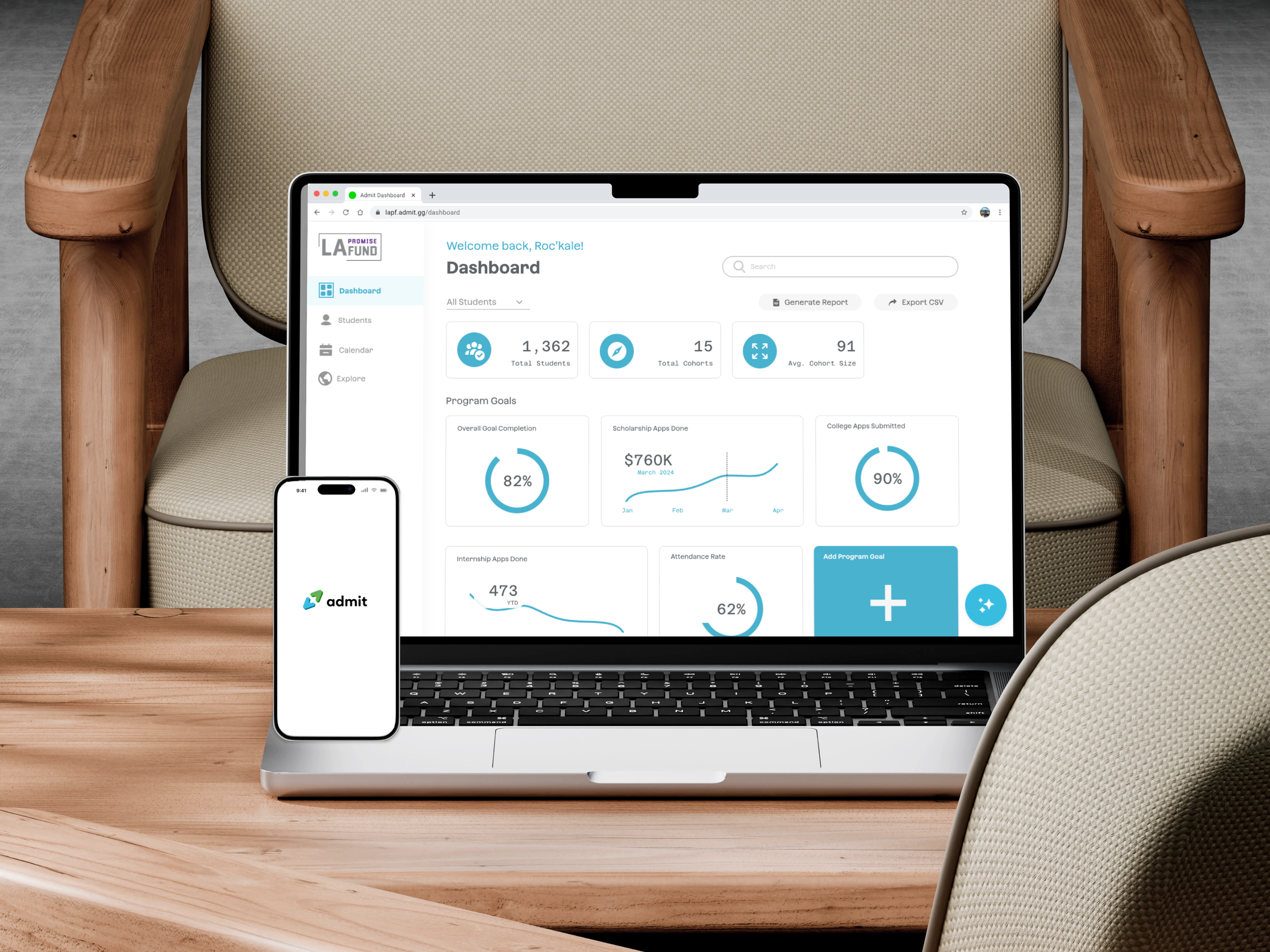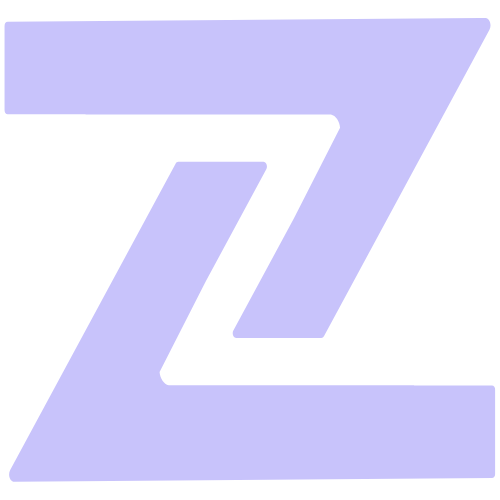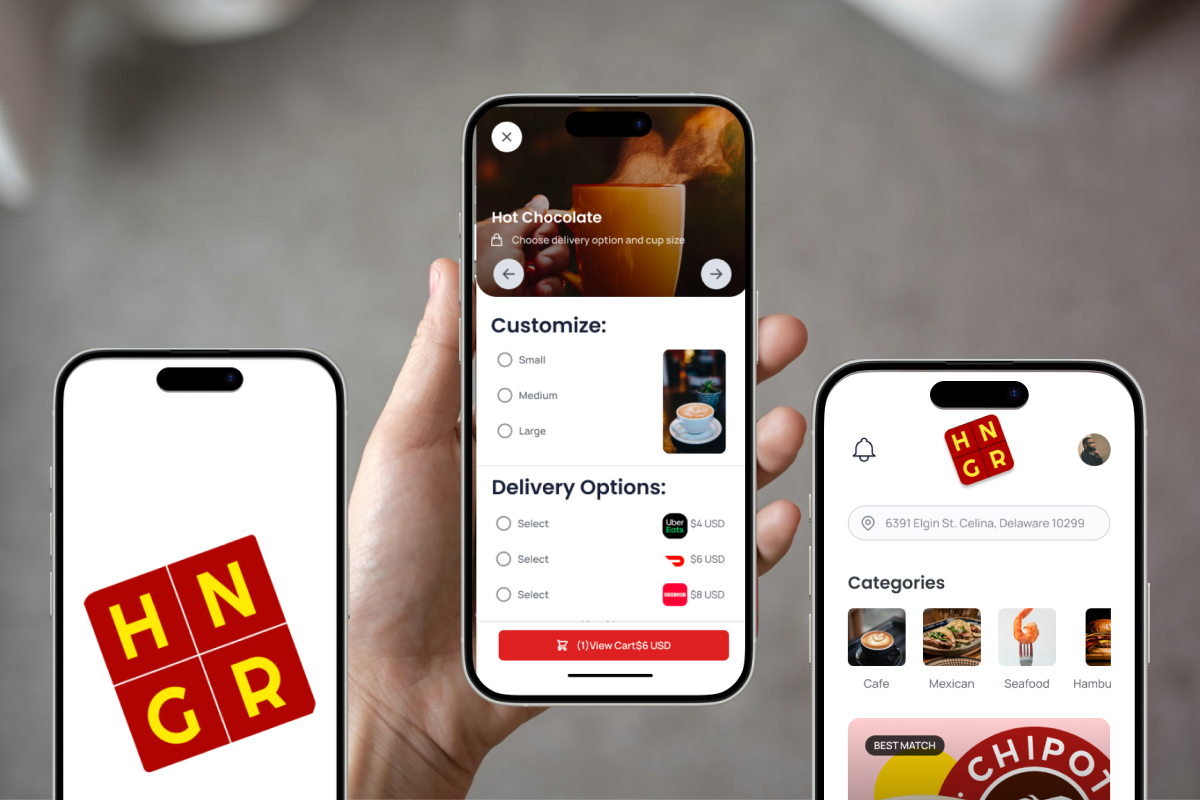
Admit Project
Project Duration
June 2024 - August 2024
Role
Lead Product Design Intern for the start-up project, Admit, for Nile Studio.
Team
Collaborated with 3 developers and my product manager.
The Problem
Navigating the college application process can be daunting for students, with deadlines, resources, and priorities often scattered across multiple platforms. For administrators, the challenge lies in supporting hundreds of students with limited tools.
The Admit project set out to tackle this dual challenge, providing students with clarity and structure while equipping administrators with actionable insights to support their communities effectively.
The Goal
After presenting this research, my client outlined the need for a solution to bridge the gap between students and counselors. They tasked me with achieving two key objectives:
For Students: Design an intuitive mobile app to help students set and track academic and career goals with personalized AI support.
For Administrators: Develop a dashboard to streamline task management, track outcomes, and support students more effectively.
This became the foundation of my design process.
Target Audience
Understanding the needs of diverse users was key to designing an impactful solution. I focused on three primary groups:
High School Students (Grades 9–12): Seeking affordable college and career guidance.
College Students (Years 1–4): Needing support to graduate and secure internships or jobs.
Administrators: Nonprofit and charter school staff managing college-bound students.
Design Process Overview
To tackle the challenges presented in this project, I followed a comprehensive design process consisting of user research, ideation, branding and visual design, wireframing and prototyping, and usability testing.
Each stage was guided by a focus on user needs and adaptability to constraints.
This process not only structured my approach but also enabled me to overcome unique challenges, such as balancing limited resources, understanding diverse user needs, and navigating the responsibilities of being the sole designer.
Here’s how each challenge shaped the final solution.
Challenge 1: Working Within Constraints
The Obstacle:
The project began without any existing design frameworks, unlike my experience at companies like Microsoft and Genius Plaza, which had established systems and resources. In a startup environment, resources were limited, which meant I had to create a design system from scratch balancing speed and quality in a resource-constrained startup environment.
The Approach:
I approached this challenge by anchoring every step of my design process—user research, feedback collection, key insights, and low-fidelity wireframing—around building a strong, adaptable foundation to solve the problem effectively
Approach:
User Research & Ideation
Feedback Collection
To ensure the design process addressed real user needs, we conducted interviews with high school students and administrators to uncover pain points. I began with targeted user research to understand key questions:
“Why is the current counseling approach not working?”
“Where do the most significant gaps exist for students and administrators?”
This research also allowed me to validate and refine the initial ideas presented by my client. Methods included:
Surveys: Collected survey responses from over 50 students to gather quantitative feedback on the prototype’s core features.
User Interviews: Held 20 in-depth sessions with low-income students and nonprofit staff (e.g., Robin Hood Foundation), uncovering pain points in goal tracking and administrative workflows.
These insights directly informed design decisions, ensuring the solution addressed both user and client needs.
Key Insights
The research revealed clear patterns in user needs and challenges, highlighting opportunities to improve both student and administrator experiences:
From Students
Goal Tracking: 70% emphasized the importance of visualizing academic progress with timely reminders.
AI Assistant: 60% valued personalized responses but desired deeper, more detailed guidance. This insight was gathered by asking targeted questions, such as:
• “What type of information do you typically seek from a counselor?”
• “How do you prefer to receive academic or career advice?”
• “Have you used AI tools before? If so, what worked and what didn’t?”
Usability: We previewed the original mockup given to me by the client and Many (55%) requested quicker navigation between features for a smoother experience.
From Administrators
Dashboard Usability: 90% needed a seamless way to track multiple student goals and create reports.
Bulk Actions: 65% identified the need for batch operations, like document uploads, to save time.
Integration: 75% wanted better compatibility with existing tools such as calendars and management systems.
These insights became the foundation for prioritizing design features, ensuring the platform addressed real-world pain points.
Personas
Based on the research, I developed two key personas to represent the platform’s core users and guide design decisions:
Andrew
A school administrator responsible for tracking the progress of 150+ students. He needs real-time data on student performance and a platform to streamline communications.
These personas anchored my design approach, ensuring it aligned with real user needs.
Alexis
A high school junior juggling multiple college application deadlines. She needs to stay organized with clear goal tracking and personalized guidance.
Brainstorming
Using the personas and research insights, I identified three core features to prioritize:
• Goal-Tracking Tools: For students to monitor progress and stay organized.
• AI-Powered Guidance: Providing personalized recommendations based on user input.
• Admin Dashboard: Streamlining workflows with real-time student progress tracking.
I sketched low-fidelity wireframes to explore these ideas, focusing on simplicity and scalability. Early iterations were refined based on feedback to ensure alignment with user needs and technical constraints.
Wireframing
Lofi Mockup 1: Goal Tracking
Lofi Mockup: AI Chat
Lofi Mockup 2: Goal Tracking
Lofi Mockup: Dashboard Home
I translated the brainstorming ideas into low-fidelity wireframes, focusing on key workflows:
Mobile App: Streamlined goal tracking with chat-based AI assistance.
Admin Dashboard: Centralized data visualization for real-time tracking and task management.
These wireframes enabled quick iterations and incorporated feedback, ensuring the designs aligned with user needs and technical feasibility.
Challenge 2: Leading Through Uncertainty
The Obstacle:
As the sole designer, I lacked a design team for feedback and critique, making it challenging to validate decisions. Additionally, I had to align designs with developers, product managers, and stakeholders in a fast-paced, evolving environment.
The Approach:
To address these challenges, I leaned on collaboration, iterative feedback, and usability testing to ensure designs met user needs and technical requirements.
Approach :
Refinement & Usability Testing
I prioritized transparency and collaboration with stakeholders, developers, and users to refine the designs:
Collaboration: Worked closely with developers to align designs with technical constraints, using feedback loops to refine solutions.
Team Scrums: Facilitated weekly scrums to align goals and foster clear communication across teams.
Usability Testing: Conducted iterative testing to identify pain points, focusing on improving navigation, clarity, and feature functionality.
Refinement - Usability Testing Results
Student Side
Positive Feedback:
Navigation: 85% of students found the navigation intuitive for goal tracking.
Clarity of Information: 75% rated the AI assistant highly for relevance and usefulness in providing college advice
Constructive Feedback:
AI Responses: 40% requested more regionally tailored AI responses
Goal Progress Tracking: 35% of users requested improvements in real-time goal tracking, as the progress bar didn’t update promptly.
Goal Organization: 50% of users found it difficult to track goals as more were added over time, especially with the monthly view becoming cluttered.
Admin Dashboard
Added Program Goal interactivy
Added “Threads” to help address AI functionality
Before
After
Simplified goal tracking by introducing dropdowns, an accordion view, priority goals, and filtering options to improve organization and simplify long-term goal management.
Admin Side
Positive Feedback:
Dashboard Efficiency: 90% of admins found the dashboard effective for student management.
Community Engagement: 74% appreciated the platform’s ability to foster community engagement through the Explore page.
Constructive Feedback:
Feature Requests: 65% wanted bulk document uploads and better integration with calendar tools like Google Calendar
Program Goal Interactivity: 68% of admins wanted to interact with Program Goals, allowing them to view details, track progress, and manage tasks efficiently.
AI Functionality: 55% desired more personalized AI suggestions, particularly in tracking student goals and financial aid.
Branding & Typography
The branding for this project was designed to balance warmth and professionalism, inspired by the friendly tone of Duolingo and the structured clarity of Slack.
Color Palette
Green: Represents growth and opportunity, evoking a sense of progress for students.
Blue: Signifies trust and clarity, aligning with administrators’ data-driven needs.
Typography
Azeret & Azert Bold was chosen for its rounded, approachable aesthetic while maintaining a professional tone. Bold weights emphasized key actions (e.g., “Next” or “Add Goal”).
Components
Component choices were driven by user needs, balancing clarity, functionality, and approachability:
Action Elements:
Rounded buttons were used for a welcoming and intuitive experience, making critical actions (e.g., “Sign Up”) visually prominent and easy to locate.
Admin Dashboard:
Focused on actionable data visualizations, enabling admins to manage student performance and tasks effortlessly while maintaining a clean and navigable interface.
Consistency:
Unified design across student and admin interfaces ensured seamless user experiences, reflecting the platform’s professional yet approachable identity.
These components enhanced usability while reflecting the platform’s identity.
The Outcomes
The Admit project delivered targeted solutions for students and administrators, improving their workflows and addressing key challenges. Here’s how:
1. Empowering Students
Goal Tracking: Students could set and monitor goals using an intuitive progress dashboard, helping them break down large academic tasks into manageable steps.
AI Recommendations: Personalized suggestions (e.g., deadlines, scholarships) reduced the overwhelming nature of college preparation.
Results: Students like Alexis reported feeling less stressed and more in control of their academic goals.
2. Simplifying Administrative Workflows
Dashboard Insights: Admins accessed clear, visual data on student performance and needs, reducing time spent on manual tracking.
Task Prioritization: Tools like automated reports highlighted students requiring urgent support, improving decision-making efficiency.
Impact: Workflow efficiency improved by 90%, enabling administrators like Andrew to allocate more time for personalized student support
3. Laying the Foundation for Scalability
Iterative Design: Feedback from testing ensured the solution was adaptable to future needs.
Broader Impact: By combining user insights and design processes, Admit not only solved immediate challenges but set the stage for scalable implementation across institutions.
Mockups & HiFi Prototypes
The Final Product
The polished design includes:
Mobile App: Goal tracking, AI-driven chatbot, and an Explore Feed fostering student engagement.
Admin Dashboard: Personalized student profiles, posting features, and calendar integration to manage tasks seamlessly.
This outcome showcases how research-driven solutions translate into actionable, user-centered designs.
Student Mobile App
Goal Tracking
Simplifies the process for students to define and pursue their objectives, combining clarity and motivation through AI-powered suggestions.
This addresses the need for a structured and personalized approach to goal-setting.
AI-Driven Chatbot
Designed to reduce barriers to information, the chatbot empowers students by providing instant access to critical resources, relieving the stress of navigating complex academic and career processes alone.
Explore Feature
Fosters a sense of community by connecting students with universities, nonprofits, and peers.
This directly responds to the need for increased accessibility to opportunities and resources in a shared space.
Dashboard Overview
Provides administrators with a centralized hub to oversee student progress, goal completions, and engagement metrics.
This tackles the challenge of keeping track of various student profiles, allowing for data-based actions.
Administrator Dashboard
Thread Posting
Enables open, interactive communication between administrators and students, ensuring updates, resources, and guidance are shared in an accessible and engaging format.
Student Profile Management
Gives administrators an efficient way to track progress and provide personalized support, addressing the challenge of managing diverse student needs in a streamlined, effective manner
Calendar Integration
Admins can schedule and manage events, deadlines, and meetings in one place.
This simplifies planning and ensures students stay on track without missing important dates.
Potential Future Development
Building on insights from usability testing and stakeholder feedback, future iterations will focus on:
1. University Posting & Promotion Management
Enhance engagement by enabling universities to share scholarships and events.
2. Enhanced Reporting & Analytics
Provide administrators with deeper insights into student performance and outreach metrics.
3. Advanced Communication Tools
Implement direct messaging between students and administrators, with personalized notifications for deadlines and university updates.
4. Customization Options for Dashboards
Allow administrators to customize dashboards, track key student metrics, and save configurations for different student groups.
5. Content Contribution to Explore Feed
Universities can contribute and promote content to the Explore Feed, with curated posts driving student engagement through trending topics.
Key Takeaways: Lessons from the Journey
Personal Impact
This project was more than just a design exercise—it was a transformative experience that tested my ability to adapt, problem-solve, and lead in a dynamic environment. Unlike my prior experiences in structured corporate settings, this startup project demanded a hands-on, iterative approach to tackling user challenges. It became a personal exploration of how thoughtful design can bridge gaps and create impact.
Growth Through Challenges
Designing for Startups
Transitioning from established systems to crafting solutions from a blank slate underscored the importance of balancing creativity with practicality. This challenge helped me develop an adaptable mindset for unstructured environments.
Adaptability in Problem-Solving
My technical background enabled effective collaboration with developers to design with technical constraints in mind, streamlining the process without compromising user needs.
Confidence in Feedback
Leaning into constructive criticism sharpened my instincts, allowing me to make design decisions with clarity while fostering open collaboration within a resource-constrained team.
Communication as a Tool
Clear, consistent dialogue with my team and manager ensured alignment, even when direction was limited. This skill became critical in bridging gaps across cross-functional teams.
Reflection
The journey was as much about personal growth as it was about creating impactful solutions. It taught me the value of resilience and creativity under pressure while reinforcing my belief in the power of design to drive meaningful change.
*All designs in this project were created via Figma
Other Projects
GNG
HNGR



























